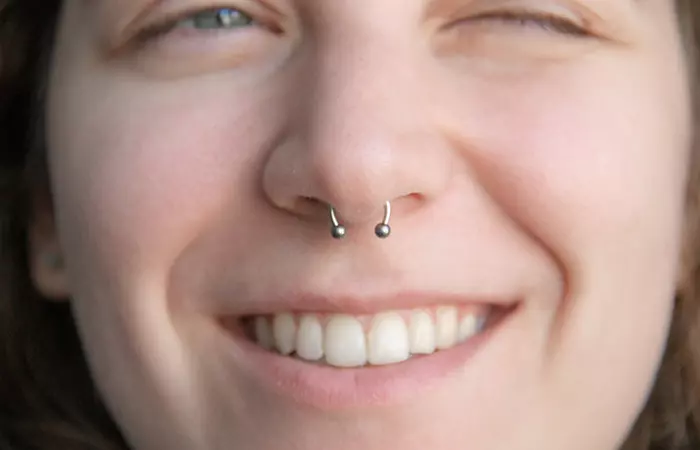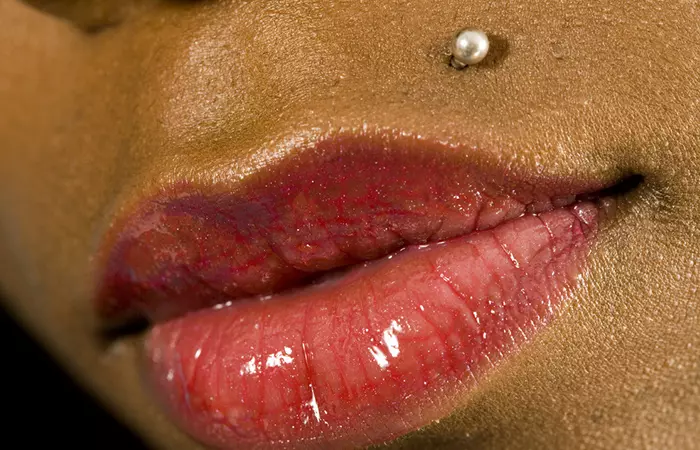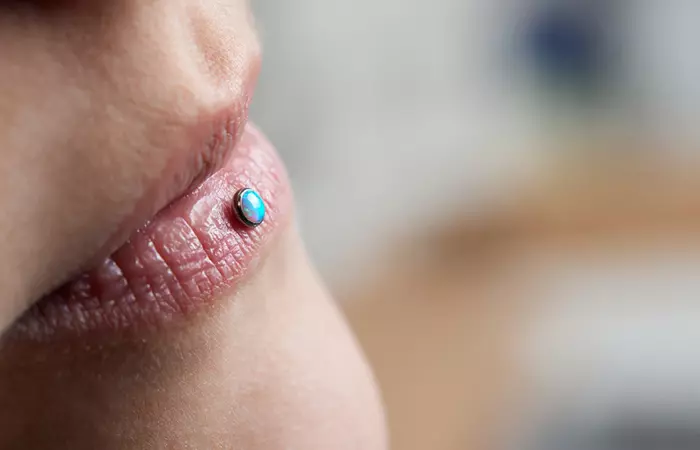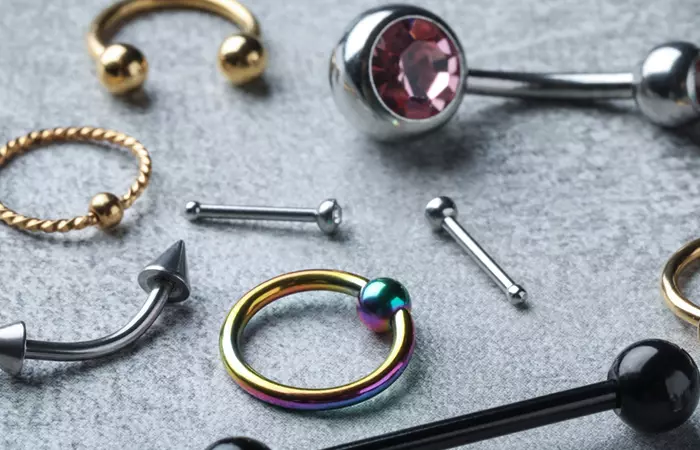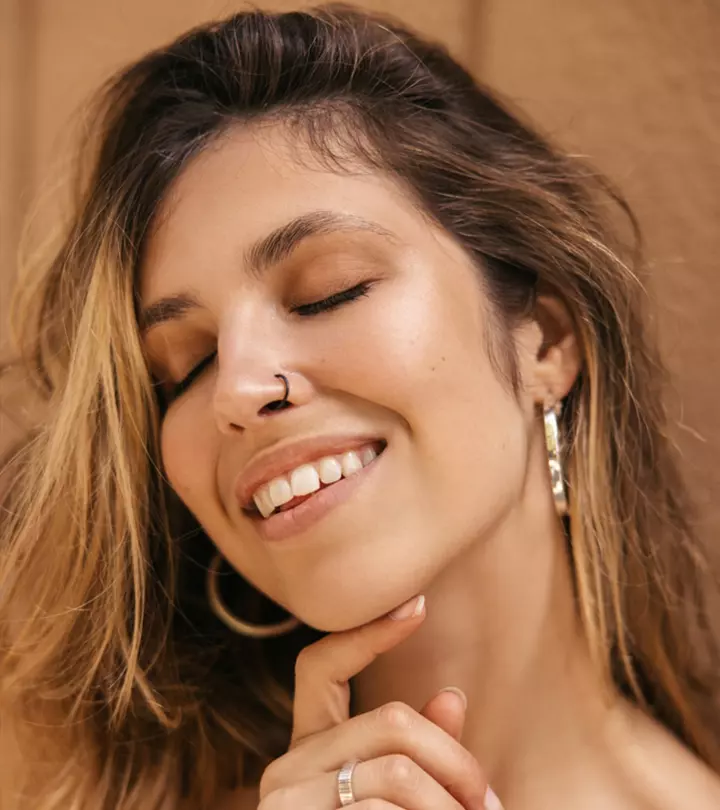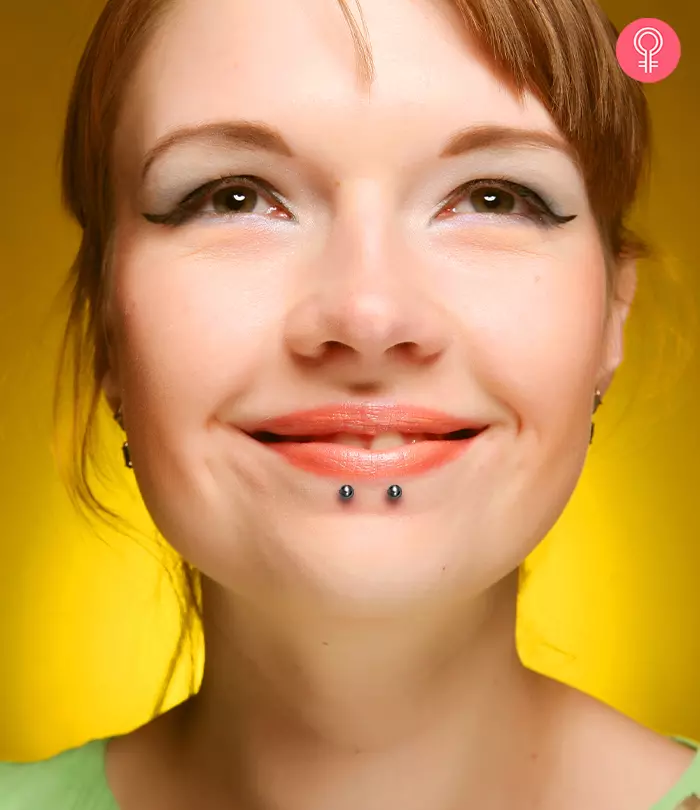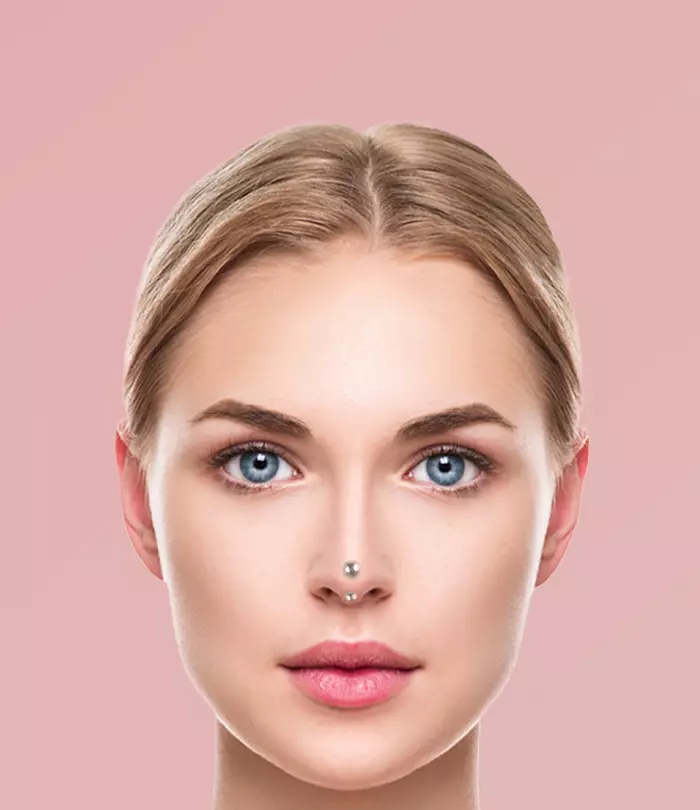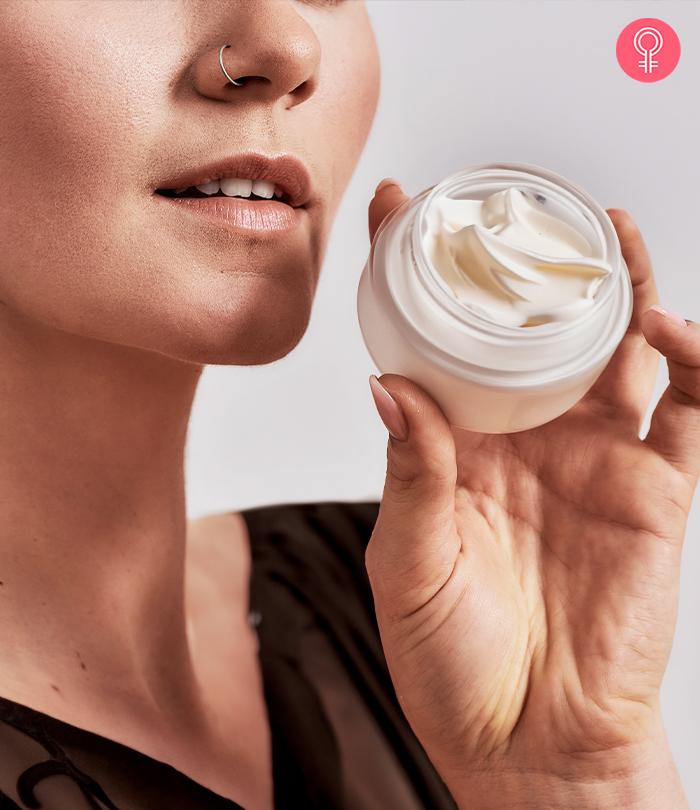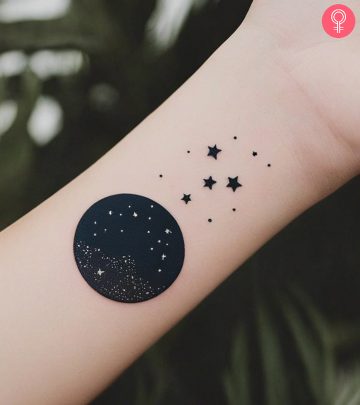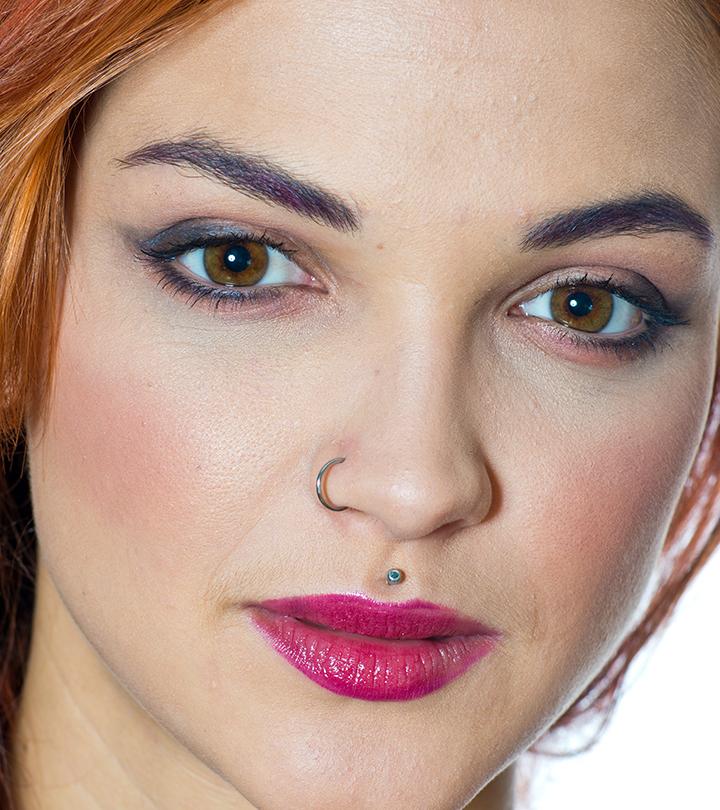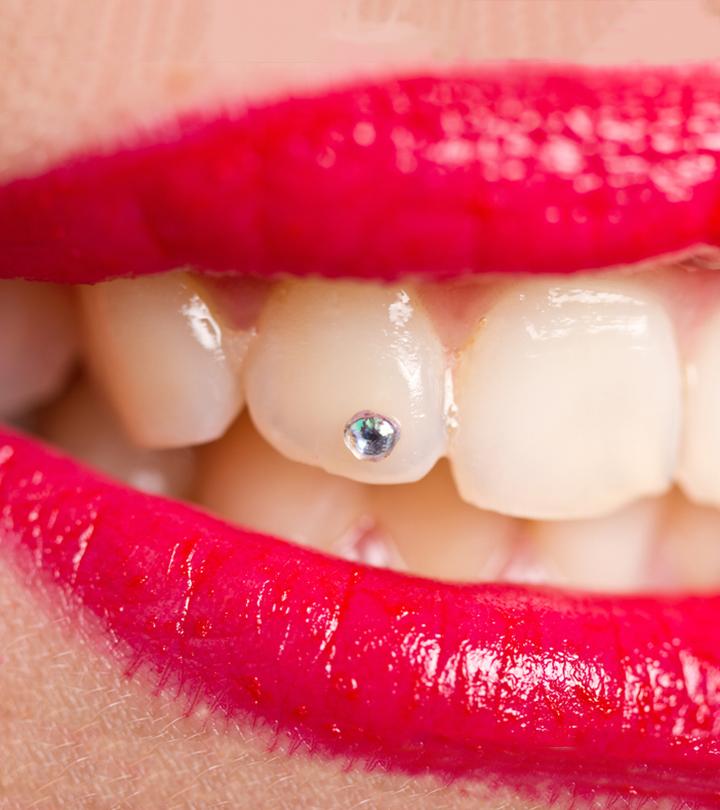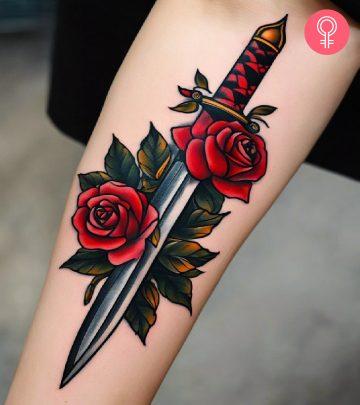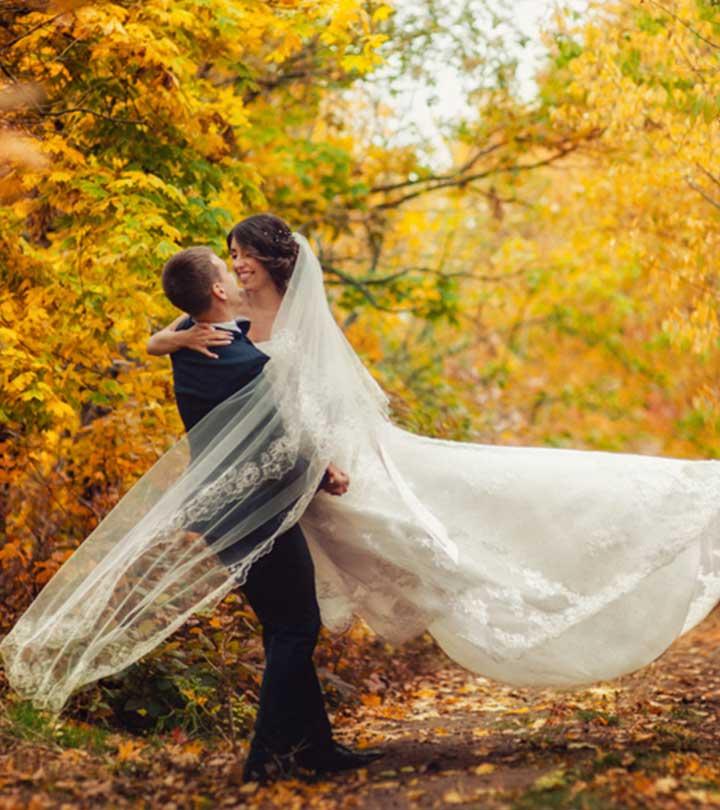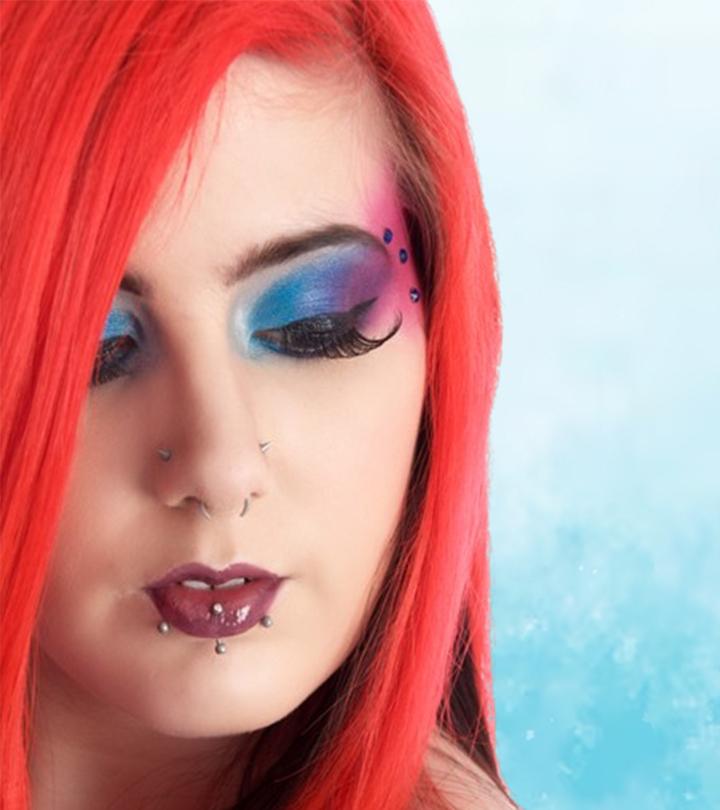Face Piercings: Types, Cost, Pain, Healing & Aftercare
Dive into the world of facial adornments and express yourself in style.
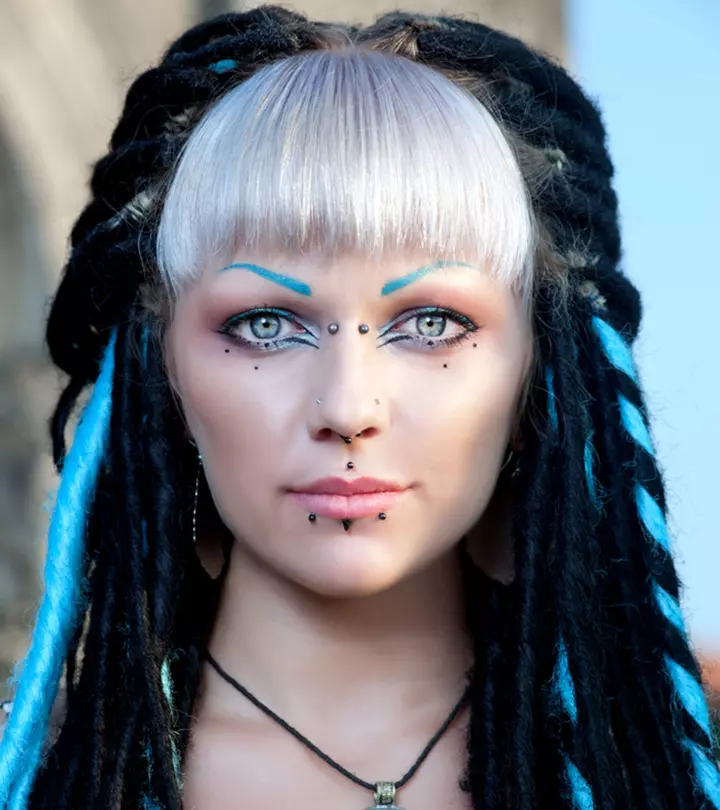
Image: Shutterstock
If you are passionate about piercings and want to use them to showcase your bold personality, face piercings offer many striking options. Whether it is a subtle nose stud that adds a touch of elegance or a daring eyebrow piercing that exudes confidence, there is a facial piercing to suit every taste and persona. However, you need to consider more than just the look you are aiming for and think about the estimated costs, pain levels, side effects, jewelry options, healing time, and aftercare. Understanding these basic elements can help you make an informed decision and get satisfying results. So, keep reading to learn all you need to know about various types of face piercings!
 Piercing Guide: Face Piercings
Piercing Guide: Face Piercings- Placement: Various locations on the face
- Best Jewelry: Studs, hoops, rings, barbells
- Cost: $30 to $150 (depends on placement)
- Pain Level: Low to medium (depends on placement)
- Healing Time: 3 to 12 months (depends on placement)
In This Article
What Is The Significance Of People Piercing Their Faces?
People choose to pierce their faces for a variety of reasons. These may range from cultural traditions and social factors to realizing their expressions of identity and selfhood. For instance, in many Indian cultures, nose piercings symbolize marital status and fertility among women. Here are a few more reasons why people choose to pierce their faces:
- To express their creativity.
- As a sign of rebellion against societal norms.
- For aesthetic purposes and to be on trend.
- To represent values, beliefs, or spiritual connections.
- As a sign of appreciation for a culture or community.
- For personal empowerment.
 Trivia
TriviaNumerous parts of your face can be pierced for a unique and fashionable look. And each person’s motivation for getting it done can be unique to their desires, experiences, and beliefs. For a look at the different types of facial piercings you can choose from, check the following section!
Facial Piercing Chart
Here is a basic face piercings chart outlining some common types of facial piercings.
This chart can serve as a vision board to help you plan the areas you want pierced and the kind of piercings you want to get. Ideally, any piercing studio you visit will have this chart so that the staff there can provide you with a reference for the different options available and help you visualize how each type of piercing will look on your face. Along with this, they will help you with pre-piercing precautions and queries that you may have and aftercare instructions.
Each of these piercings has its own aesthetic appeal and significance as attributed. Scroll down to learn about the many options for facial piercings along with their estimated costs.
Different Types Of Facial Piercings
The most popular categories of face piercings are as follows:
1. Vertical Eyebrow Piercing
It is a surface piercing that appears along the eyebrow. It is inserted through the bottom of the eyebrow, which is its entry point, and the exit point is through the top.
- Cost: Around $30 to $40
2. Horizontal Eyebrow Piercing
View this post on Instagram
It is a Surface Piercing that is placed horizontally, either just above or below the eyebrow hair. In some cases, it may also be placed within the actual brow. This horizontal piercing may also be slightly angled to suit specific face anatomies.
- Cost: Around $30 to $40
 Trivia
Trivia3. Third Eye Piercing
View this post on Instagram
It is a surface piercing that is done vertically in the middle of your forehead, an area that corresponds to the third eye chakra. This makes the piercing ideal for spirituality seekers looking to express their beliefs through body modification. It is also known as the forehead dermal piercing, unicorn piercing, and Medusa third eye piercing.
- Cost: Around $35 to $40
4. Bridge Piercing
This eye-catching surface piercing, also known as the Erl piercing, is a tribute to Erl Van Aiken, who made this piercing famous. It is a bold and edgy piercing that sits right across the bridge of your nose, between your eyebrows for a symmetrical look.
- Cost: Around $30 to $40
5. Crow’s Feet Piercing
View this post on Instagram
This piercing is placed close to the temples, near the side of your eyes. Since this is the area where wrinkles commonly known as crow’s feet appear, the piercing name was thus inspired.
- Cost: Around $40-$60.
6. Anti-Eyebrow Piercing
View this post on Instagram
Also known as the butterfly kiss piercing, this one is placed directly opposite the eyebrow along the cheekbone, below the eye. This surface piercing is usually placed vertically but may also be done horizontally, depending on your preference.
- Cost: Around $40 to $60
7. Teardrop Piercing
View this post on Instagram
If you like the placement of the anti-eyebrow piercing, you may also like the teardrop piercing. While there are some mixed opinions about whether this one is the same as an anti-eyebrow, the barbell jewelry used for an anti-eyebrow piercing is swapped for a sleeker dermal anchor in this one.
- Cost: Around $40 to $60
8. Nostril Piercing
This is one of the most popular piercings that serves as the entry point to facial piercings. It is placed through the tissue of the nostril near the crease, where the nostril meets the cheek. You may get it done on either side of your nose or both at the same time!
- Cost: Around $25 to $30
9. Rhino Piercing
View this post on Instagram
This nose piercing is also known as a vertical tip piercing. It goes through the tip of the nose vertically, from the outside surface to the inside. It gets its name because it resembles the horn of a rhinoceros when viewed from certain angles.
- Cost: Around $50 to $100
10. Septril Piercing
View this post on Instagram
This facial piercing involves piercing the area where the septum of the nose and the vertical groove between the base of the nose and the upper lip meet. It is relatively uncommon but quite adorable.
- Cost: Around $50 to $100
11. Septum Piercing
Once only seen on cartoon bulls, this body piercing involves the septum, which is the fleshy cartilage tissue between your nostrils. Instead of the thick cartilage, it goes through the softer space of tissue just below the septum.
- Cost: Around $40 to $100
Septum piercings are quirky, but not everybody may like how they look on them. For instance, Victoria, a blogger, got a septum piercing and liked it initially. However, there came a point where she started falling out of love with her body piercing. She writes in one of her posts, “I told myself I would give myself four months to see if I wanted to keep it in, I didn’t think one month would be long enough. I stuck to that promise to myself and one night, I took it out and felt so much better the minute I did (i).”
12. High Nostril Piercing
View this post on Instagram
Instead of being positioned near the crease of the nostril, this type of nose piercing is typically placed closer to the bridge of the nose. However, the exact placement may vary depending on your anatomy and aesthetic preferences.
- Cost: Around $25 to $30
13. Nasallang Piercing
View this post on Instagram
This is a rather rare and complex facial piercing that passes through all three cartilage walls of the nose. These include both your nostrils and the septum, making this cartilage piercing quite painful.
- Cost: Around $50 to $100
14. Austin Bar Piercing
View this post on Instagram
This type of nose piercing does not traverse the nostrils or the septum. Instead, it runs horizontally through the nasal cap. Popular lore suggests that the name of this rare piercing that runs through the tip of your nose comes from the first person to have worn it.
- Cost: Around $25 to $65
15. Cheek Piercing
A type of body modification wherein a small hole is pierced through the cheek, usually to create the appearance of dimples when the person wearing it smiles. Since the piercing gives you faux dimples and is also placed in the crease where dimples naturally occur, it is sometimes called a dimple piercing.
- Cost: Around $40 to $100
16. Medusa Piercing
This body piercing goes through the philtrum, which is the indented area above your upper lip. Due to this, it is also sometimes known as the philtrum piercing. As for its original name, it comes from the Greek mythological figure, Medusa who was known for her alluring beauty.
- Cost: Around $40 to $100
17. Madonna Piercing
Also known as the Crawford piercing, this lip piercing type is located above the upper lip, off-center to the right side. It gets its name from the iconic pop singer Madonna, who sported a similar piercing.
- Cost: Around $50 to $80
18. Monroe Piercing
This facial piercing is located on the upper lip, off-center to the left side. It is meant to mimic the beauty mark famously associated with Marilyn Monroe, hence the name.
- Cost: Around $50-80.
19. Angel Bites Piercing
View this post on Instagram
This consists of two symmetrical piercings placed on either side of the upper lip. The piercing is sometimes called a Madonna-Monroe piercing because it combines the placement of both these piercings.
- Cost: Around $60 to $120
20. Dahlia Bites Piercing
View this post on Instagram
This facial piercing involves two piercings placed symmetrically at the corners of the mouth. It is named after the story of Elizabeth Short, an actress who was murdered in the 1940s and left with a smile carved into her face. She was nicknamed “The Black Dahlia” as a reference to the noir mystery thriller The Blue Dahlia and Short’s fondness for black sheer clothing. Since the placement of the piercing resembles the endpoints of the smile, it is known as Dahlia bites, or simply the Dahlia piercing.
Cost: Around $40 to $80
21. Spider Bites Piercing
View this post on Instagram
It involves two separate punctures placed closely together on one side of the lower lip, resembling the fang marks of a spider. You may get this symmetrical piercing on either side of your face.
- Cost: Around $40 to $80
22. Shark Bites Piercing
View this post on Instagram
If you love the spider bite piercing, this one just replicates it on the other side of your lip. It involves four separate punctures in two pairs, typically two on each side of the lower lip.
- Cost: Around $80 to $150
23. Jestrum Piercing
View this post on Instagram
Also known as the vertical medusa piercing, this facial piercing goes through the center of the upper lip, exiting from the underside of the lip, similar to a traditional medusa piercing. However, instead of the jewelry sitting horizontally, it features a curved barbell that passes through the upper lip vertically and emerges from the underside of the lip.
- Cost: Around $30 to $60
24. Labret Piercing
This lip piercing is located on the lower lip, specifically in the center, just below the upper lip. It typically involves inserting a piece of jewelry that sits perpendicular to the lip, with one end inside the mouth and the other visible externally.
- Cost: Around $30 to $100
25. Vertical Labret Lip Piercing
This facial piercing involves a single puncture through the center of the lower lip. It exits from the top side of the lip, and unlike labret piercings, goes through the lower lip vertically, avoiding the inside of the mouth.
- Cost: Around $30 to $100
26. Snake Bites Piercing
View this post on Instagram
This double lip piercing sits near the outer corners of the lower lip’s edge, wherein each of the piercings is positioned equidistant from the center of the lip. As the name suggests, this placement resembles the fangs of a snake or a snake bite.
- Cost: Around $60 to $120
27. Dolphin Bites Piercing
View this post on Instagram
Like a snake bites piercing, this one also involves two separate piercings placed closely together on the lower edge of the lower lip. They are just positioned closer than snake bites and are meant to replicate the look of the narrow mouth of a dolphin, and how a dolphin bite may appear.
- Cost: Around $50 to $100
28. Eye Piercing
View this post on Instagram
Though this piercing is discouraged by doctors and is very rarely heard of, this science-fiction-adjacent piercing is still a thing. Also known as the corneal or eyeball piercing, this one involves puncturing the cornea, the transparent outer layer of the eye, to implant the jewelry. The piercing is highly controversial and linked to vision impairment and even blindness as it involves perforating such a sensitive area of the eye.
- Cost: Around $3000
The jewelry you choose for your face piercings is as important as the piercing placements, as it will directly affect their appearance. Hence, it is important to choose the best one for your needs. The following section will not only give you an idea about the best face piercing jewelry types and materials but also tell you how to change them safely. Check it out!
Face Piercing Jewelry
Your face-piercing jewelry is not only important for the look of your piercing but also plays an important role in its healing process. The right jewelry type and material will ensure that your new body modification stays infection-free (1). Also, investing in high-quality jewelry and knowing how and when to change it safely typically means it will last longer. In this section, we will dive into all these details about face-piercing jewelry.
1. Types Of Jewelry
Facial piercings can be adorned with various types of jewelry, each offering different styles, sizes, and materials to suit personal preferences and piercing placements. Studs and rings are the most common types of jewelry pieces you can opt for. They come in a variety of designs and with gemstones and are commonly used for eyebrow, nose, and lip piercings. A few other jewelry types that are used for face piercings include:
- Circular Barbell: Also known as a horseshoe barbell, it is a U-shaped jewelry piece that has decorative balls at the ends. It is perfect for adorning septum and lip piercings.
- Captive Bead Ring: It is a hoop-shaped piece with a small bead or ball that is held in place by the tension of the ring. It is used for lip, nose, and eyebrow piercings.
- Straight Barbell: It is a straight bar with threaded ends that can accommodate decorative beads, balls, or ornaments. It is commonly used for tongue, lip, eyebrow, and cheek piercings.
- Curved Barbell: It is a slightly curved bar with threaded ends that can accommodate decorative beads, balls, or ornaments. It is ideal for vertical labret piercings.
- Labret: It is a type of stud with a flat backplate and a removable end with decorative designs. It is ideal for lip and nostril piercings.
2. Tips To Choose The Right Material And Size
Along with the type of face-piercing jewelry piece, it is also important to consider its material and size. This helps ensure safety and comfort and minimizes the risk of allergic reactions. Here are some tips for choosing the best materials for your facial piercing jewelry:
- If you have sensitive skin, opt for jewelry made from implant-grade titanium that is rarely linked to allergies (2). This kind of jewelry is also durable, nickel-free, and non-corrosive.
- You may also opt for 14k or 18k gold, as it is unlikely to cause an allergic reaction. However, jewelry made from it may sometimes contain nickel, which is known to cause skin issues (3). Therefore, always look for nickel-free variants.
- Platinum is another precious metal you can opt for as your face-piercing jewelry. Pieces made from it have a brilliant luster and it also has rare cases of causing allergies. (4).
- You may opt for pure sterling silver, which is mostly considered safe but may sometimes contain nickel (3).
- If you need an affordable metal for your face jewelry, you may opt for surgical-grade stainless steel. However, keep in mind that it may have a small amount of nickel (3).
- Quality plastic materials like bioplast are another option you can choose. Ideally, you may wear plastic jewelry until your piercing is healed. Then, you may replace it with a jewelry material of your choice (5). However, if you have metal sensitivities, you may consult your piercer to confirm if you can keep wearing plastic jewelry.
Further, when it comes to the size of your facial piercing jewelry, there are two factors to consider–the gauge size of both the jewelry ornament and the piercing. gauge size refers to the thickness of the jewelry, and it will depend on your piercing size. Your piercer can help you determine which gauge size is appropriate for you.
For the size of the jewelry ornament, you may have to consider your personal taste and facial features. For instance, if you want your piercing to be the highlight of your face, you may opt for a jewelry piece with large decorative elements and designs. If you are unsure about it, ask your piercer to show you different jewelry options so you can visualize how they may look on your face.
3. When And How To Change The Face Piercing Jewelry?
Since the piercing jewelry piece can affect the appearance of your piercing, it is common for people to experiment with it. This requires changing them, which should be done carefully and after a certain period to avoid infection or irritation. Let us first talk about when to change your face piercing jewelry.
Ideally, it is important to wait until your piercing is fully healed before attempting to change the jewelry. Changing it too soon may irritate your piercing and disrupt its natural healing process, leading to the risk of complications. To ensure your piercing has fully healed, inspect it for signs like redness, swelling, tenderness, or discharge, and whether you can easily move the jewelry in the piercing hole. If you notice any of these symptoms and face hindrances moving the piece, wait for a few more days. In case there are no such signs, you may proceed with the following steps to change the jewelry:
- Wash your hands thoroughly with antibacterial soap and warm water to reduce the risk of introducing bacteria to the piercing site.
- Clean the new jewelry with a saline solution to remove any dirt or debris from it.
- Clean the piercing site with saline solution and gently rotate the jewelry to loosen any debris.
- Carefully unscrew the old jewelry and slip it out of the piercing hole gently. You may apply a lubricant like petroleum jelly to make the jewelry removal process easier
- If you encounter any resistance, do not force it. Instead, gently wiggle the jewelry back and forth while pulling it out.
- Once the old jewelry is removed, wash the hole with saline solution again and rinse with clean water.
- Pat dry the area and insert the new jewelry into the piercing site.
- Once in place, securely fasten it, and you are done!
In case you are unsure or uncomfortable with changing the jewelry yourself or are doing so for the first time, it is a good idea to seek assistance from a professional piercer.
Once you have settled on the details of the piercing, you must also prepare yourself for the pain. The level of pain experienced during each of these piercing types may vary from person to person. Scroll down to the next section for a general overview.
Do Face Piercings Hurt?
The level of pain you may experience during a face piercing may vary from person to person. It depends on several factors, such as the location of the piercing, individual pain tolerance, and the skill and technique used by the piercer. According to anecdotal evidence, each of the piercings below have been ranked on a pain scale of 1-10, with 10 being the most painful:
| Piercing Type | Pain Scale Rating |
|---|---|
| Eyebrow Piercing | 3/10 |
| Horizontal Eyebrow Piercing | 3/10 |
| Third Eye Piercing | 3/10 |
| Bridge Piercing | 7/10 |
| Crows Feet Piercing | 3/10 |
| Anti-Eyebrow Piercing | 3-4/10 |
| Teardrop Piercing | 3/10 |
| Nostril Piercing | 3/10 |
| Rhino Piercing | 3-4/10 |
| Septril Piercing | 8/10 |
| Septum Piercing | 7/10 |
| High Nostril Piercing | 3-4/10 |
| Nasallang Piercing | 8/10 |
| Austin Bar Piercing | 4-6/10 |
| Cheek Piercing | 4-6/10 |
| Medusa Piercing | 5/10 |
| Madonna Piercing | 4/10 |
| Monroe Piercing | 4/10 |
| Angel Bites Piercing | 3-5/10 |
| Dahlia Bites Piercing | 3-5/10 |
| Spider Bites Piercing | 4/10 |
| Shark Bites Piercing | 4/10 |
| Jestrum Piercing | 5/10 |
| Labret Piercing | 4/10 |
| Vertical Labret Lip Piercing | 4/10 |
| Snake Bites Piercing | 3-5/10 |
| Dolphin Bites Piercing | 3-5/10 |
| Eye Piercing | Little to no pain as it uses an anesthetic |
That said, the amount of pain you experience while getting any of these piercings may be different from what others do. While some people may only experience a slight discomfort or a sharp sensation during the piercing process, others may find face piercings to be quite painful. Therefore, it is a good idea to discuss any concerns or questions you may have with your piercer beforehand.
The pain you experience while getting a face piercing is usually brief. The little discomfort after it also gets better as your piercing heals. However, how long can this take? Let us find out in the next section.
How Long Do Face Piercings Take To Heal?
Below is a general estimate of how long it takes for face piercings to heal:
| Piercing Types | General Healing Periods |
|---|---|
| Eyebrow Piercing | 6-8 weeks |
| Horizontal Eyebrow Piercing | 6-8 weeks |
| Third Eye Piercing | 6-9 weeks |
| Bridge Piercing | 8-12 weeks |
| Crows Feet Piercing | 6-8 weeks |
| Anti-Eyebrow Piercing | 6-8 weeks |
| Teardrop Piercing | 8-12 weeks |
| Nostril Piercing | 6-8 weeks |
| Rhino Piercing | 6-9 weeks |
| Septril Piercing | 9-12 weeks |
| Septum Piercing | 6-8 weeks |
| High Nostril Piercing | 6-8 weeks |
| Nasallang Piercing | 6-8 weeks |
| Austin Bar Piercing | 6-10 weeks |
| Cheek Piercing | 8-12 weeks |
| Medusa Piercing | 6-10 weeks |
| Madonna Piercing | 6-10 weeks |
| Monroe Piercing | 8-12 weeks |
| Angel Bites Piercing | 8-12 weeks |
| Dahlia Bites Piercing | 8-12 weeks |
| Spider Bites Piercing | 6-12 weeks |
| Shark Bites Piercing | 8-12 weeks |
| Jestrum Piercing | 6-12 weeks |
| Labret Piercing | 6-8 weeks |
| Vertical Labret Lip Piercing | 6-10 weeks |
| Snake Bites Piercing | 4-6 weeks |
| Dolphin Bites Piercing | 8-12 weeks |
| Eye Piercing | A few days to weeks |
It is important to note that this is just a general idea of how long each of these piercings may take to heal. The actual healing time for face piercings may vary depending on various factors, such as your body’s healing process and how well you take care of it.
During the healing process, it is essential to follow proper aftercare instructions provided by your piercer to ensure quick recovery. The following section will give you an insight into what your aftercare practices should include. Read on.
Aftercare Tips For Face Piercing
Here are some face piercing aftercare tips you may follow to ensure your piercing heals without any complications:
- Ensure to wash your hands with a mild, fragrance-free soap and water before touching your face piercing.
- Avoid touching it unnecessarily as it may introduce bacteria and increase the risk of infections.
- Clean the piercing twice a day with saline solution and avoid using alcohol, hydrogen peroxide, or harsh chemicals on the piercing site, as they may irritate and delay healing.
- Avoid rotating or twisting the jewelry unnecessarily as this may cause irritation and disrupt the healing process.
- Avoid applying makeup or skincare products directly on the piercing site, as they may irritate and increase the risk of infections.
- Avoid swimming in pools, hot tubs, or natural bodies of water until the piercing is fully healed to prevent the introduction of bacteria and the risk of infections (6).
- Be extra careful when brushing your hair, putting on clothing, or engaging in activities where the piercing may get caught or bumped to avoid trauma to your new piercing.
- Avoid sleeping on the side of the piercing to prevent irritation and discomfort.
Along with following these aftercare tips, ensure to keep an eye on your face piercing for any signs of infection, such as increased redness, swelling, pain, or smelly discharge. If you notice any of these symptoms, seek medical advice immediately (7).
Ensuring that your facial piercing stays clean is among the most important aftercare practices you should follow. While we are at it, let us give you a quick look into how to do it safely. Scroll down to find out.
How To Clean Face Piercings
Cleaning your face piercings properly is important to prevent infections and promote quick healing. Here is a step-by-step guide on how you can do it:
- Wash Your Hands: Before touching your piercing, thoroughly wash your hands with a mild, antibacterial soap and warm water to reduce the risk of introducing pathogens.
- Prepare Saline Solution: You may either use a store-bought saline solution or prepare it at home using non-iodized sea salt and warm distilled water. To make, add 2 teaspoons of salt to 4 cups of water and stir until the salt is completely dissolved.
- Clean The Piercing: Dip a clean cotton pad or cotton ball into the saline solution until it is saturated but not dripping. Use it to gently clean around the piercing site. Ensure to remove any crust or discharge that may have accumulated. Also, avoid rotating the jewelry while doing so, as it may irritate the piercing.
- Rinse Thoroughly: After cleaning the piercing, rinse the area with warm water to remove any remaining salt water residue. Pat dry the area using a clean paper towel.
So, you have settled on the perfect face piercing options for yourself. However, before you go ahead, it is important to note that all piercings come with certain risks. The next section elaborates further on this.
Side Effects Of Face Piercings
Your fresh face piercings require diligent care and attention until fully healed, and even then some. However, despite your best efforts, they come with potential side effects. Some of them include:
- Infection: One of the most common risks associated with any piercing (7). Signs of contamination may include increased redness, swelling, warmth, pain, and pus discharge.
- Allergies: Some people may experience allergic reactions to the metal used in the piercing jewelry, especially if they are sensitive to nickel (3).
- Rejection/Migration: Like with every piercing, face piercings carry a risk of scarring and rejection or migration. It is where the body pushes the jewelry out of the piercing or shifts it from its original placement as it deems it to be a foreign object (8).
- Skin trauma caused due to piercings may also increase the risk of keloids, a thick raised scar that usually forms when the healing process of the piercing goes awry (9).
- Sometimes, there may be mild cases of bleeding after the piercing. While a little of it is normal, if you experience excessive bleeding, reach out to a piercer or a medical expert immediately.
- Some research also suggests that face piercings may be linked with impaired postural control and body pain (10).
- In the case of facial piercings located near the mouth, such as lip piercings, if the jewelry comes into contact with your teeth or gums, it may irritate them and result in gum recession and chipped teeth (11).
Along with all these side effects, another concern linked with facial piercings is their effect on your professional life. In client-facing roles or industries like healthcare, where a professional appearance is paramount, visible facial piercings may be discouraged or prohibited (12). Therefore, it is a good idea to keep your professional goals in mind before getting a face piercing.
Face piercings are a form of self-expression that can help you bring out your personality. While some piercings, like the subtle nostril piercing, are commonly seen across cultures, others like the septril and Austin bar piercings are daring choices that are somewhat rare. However, rather than looking at them as just aesthetically pleasing choices or personal style statements, it is important to recognize the potential complications that can arise with getting these piercings. You must follow proper aftercare practices and clean them diligently to ensure your facial piercings stay infection-free and heal quickly.
Frequently Asked Questions
What is the safest facial piercing to get?
A nostril piercing is often considered one of the safest facial piercings you can get, as it is comparatively lower on the pain scale and has a relatively quick healing time. Due to this, people often get it as their first facial piercing. However, it is important to note that these factors may vary from person to person. Therefore, it is crucial to consult with a professional piercer before deciding on the safest facial piercing for you.
Can I get a facial piercing while pregnant?
No, it is generally not recommended to get any piercings, including facial piercings, while pregnant, as the immune function is usually compromised during this period (13). This may increase the risk of infection and complications; hence, professional piercers generally advise waiting until after childbirth before considering any piercings.
Can I get 3 face piercings at once?
While it is technically possible to get three face piercings at once, it is generally not recommended. This is because getting multiple piercings in one session may increase the risk of complications such as excessive bleeding and pain. Experts usually consider it safer to break down the piercings over several sessions to allow each one of them to heal properly and reduce the strain on your body’s healing process.
Key Takeaways
- Facial piercings serve as a bold form of self-expression and can symbolize creativity, rebellion against norms, cultural appreciation, and personal empowerment.
- There are various kinds of face piercings, among which the nostril piercing is the most popular. Other types include septum, rhino, teardrop, Medusa, and cheek piercings.
- Proper aftercare is crucial for ensuring the healing of these piercings and preventing infections. This includes regular cleaning with saline solution, avoiding unnecessary touching, and being cautious during daily activities to prevent trauma to the piercing.
- They come with potential risks such as infections, allergic reactions, scarring, rejection, and gum irritation.
Face piercings are becoming increasingly popular for their aesthetic appeal and as an edgy style statement. The following video talks about a popular type of facial piercing – the anti-eyebrow piercing. Click on the play button to learn more about it.
Personal Experience: Source
StyleCraze's articles are interwoven with authentic personal narratives that provide depth and resonance to our content. Below are the sources of the personal accounts referenced in this article.
(i) Why I took my septum piercing out.
https://retrosnowflakes.wordpress.com/2018/08/19/why-i-took-my-septum-piercing-out/
References
Articles on StyleCraze are backed by verified information from peer-reviewed and academic research papers, reputed organizations, research institutions, and medical associations to ensure accuracy and relevance. Read our editorial policy to learn more.
- Jewelry for initial piercings
https://safepiercing.org/jewelry-for-initial-piercings/ - Prevalence of titanium hypersensitivity in patients with titanium implants: a systematic review and meta-analysis
https://www.ncbi.nlm.nih.gov/pmc/articles/PMC8686894/ - Management of contact dermatitis due to nickel allergy: An update
https://www.ncbi.nlm.nih.gov/pmc/articles/PMC3047925/ - Positive patch-test reactions to platinum are rare
https://pubmed.ncbi.nlm.nih.gov/18627687/ - Art of prevention: A piercing article about nickel
https://www.ncbi.nlm.nih.gov/pmc/articles/PMC7330428/ - Infections acquired via fresh water: From lakes to hot tubs
https://journals.asm.org/doi/10.1128/microbiolspec.iol5-0019-2015 - Body piercing infections
https://www.ncbi.nlm.nih.gov/books/NBK537336/ - Body piercing
https://www.ncbi.nlm.nih.gov/pmc/articles/PMC1496593/ - Keloid
https://www.ncbi.nlm.nih.gov/books/NBK507899/ - Face piercing (body art): Choosing pleasure vs. possible pain and posture instability
https://www.ncbi.nlm.nih.gov/pmc/articles/PMC3177080/ - Oral complications associated with the piercing of oral and perioral tissues and the corresponding degree of awareness among public and professionals: A systematic review
https://www.mdpi.com/2075-4418/13/21/3371 - Should physicians have facial piercings?
https://www.ncbi.nlm.nih.gov/pmc/articles/PMC1490068/ - Infections in pregnancy
https://www.ncbi.nlm.nih.gov/pmc/articles/PMC7152168/
Read full bio of Madhumati Chowdhury
Read full bio of Vaishali Sinha









